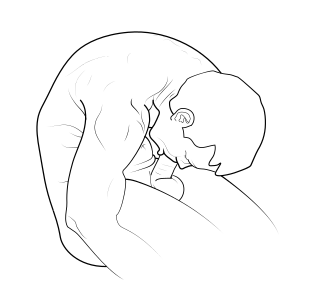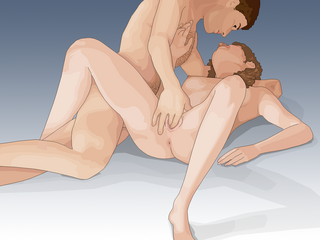
Human sexual activity, human sexual practice or human sexual behaviour is the manner in which humans experience and express their sexuality. People engage in a variety of sexual acts, ranging from activities done alone to acts with another person in varying patterns of frequency, for a wide variety of reasons. Sexual activity usually results in sexual arousal and physiological changes in the aroused person, some of which are pronounced while others are more subtle. Sexual activity may also include conduct and activities which are intended to arouse the sexual interest of another or enhance the sex life of another, such as strategies to find or attract partners, or personal interactions between individuals. Sexual activity may follow sexual arousal.

Sexual intercourse is sexual activity involving the insertion and thrusting of the male penis inside the female vagina for sexual pleasure, reproduction, or both. This is also known as vaginal intercourse or vaginal sex. Sexual penetration has been known by humans since the dawn of time, and has been an instinctive form of sexual behaviour and psychology among humans. Other forms of penetrative sexual intercourse include anal sex, oral sex, fingering and penetration by use of a dildo, and vibrators. These activities involve physical intimacy between two or more people and are usually used among humans solely for physical or emotional pleasure. They can contribute to human bonding.

Sexual abstinence or sexual restraint is the practice of refraining from sexual activity for medical, psychological, legal, social, philosophical, moral, religious or other reasons. Sexual abstinence is distinct from asexuality, which is a sexual orientation where people feel little or no sexual attraction. Celibacy is sexual abstinence generally motivated by factors such as an individual's personal or religious beliefs. Sexual abstinence before marriage is required in some societies by social norms, or by law in some countries. It is a part of chastity.

Bondage, in the BDSM subculture, is the practice of consensually tying, binding, or restraining a partner for erotic, aesthetic, or somatosensory stimulation. A partner may be physically restrained in a variety of ways, including the use of rope, cuffs, bondage tape, or self-adhering bandage.

Asexuality is the lack of sexual attraction to others, or low or absent interest in or desire for sexual activity. It may be considered a sexual orientation or the lack thereof. It may also be categorized more widely, to include a broad spectrum of asexual sub-identities.

Autofellatio is a form of masturbation involving the oral stimulation of one's own penis. Only a limited number of males are physically capable of performing fellatio on themselves due to the flexibility required.

Self-bondage refers to the use of restraints on oneself for erotic pleasure. It is a form of erotic bondage which can be practiced alone.
Autoerotic fatalities are accidental deaths that occur during sexual self-stimulation when an apparatus, device or prop that is being employed to enhance pleasure causes the death. Researchers only apply the term to unintentional deaths resulting from solitary sexual activity, not suicide or acts with a partner. The incidence of autoerotic fatalities in Western countries is around 0.5 per million inhabitants each year.
Hypoactive sexual desire disorder (HSDD), hyposexuality or inhibited sexual desire (ISD) is sometimes considered a sexual dysfunction, and is characterized as a lack or absence of sexual fantasies and desire for sexual activity, as judged by a clinician. For this to be regarded as a disorder, it must cause marked distress or interpersonal difficulties and not be better accounted for by another mental disorder, a drug, or some other medical condition. A person with ISD will not start, or respond to their partner's desire for, sexual activity. HSDD affects approximately 10% of all pre-menopausal women in the United States, or about 6 million women.
Sexual dysfunction is difficulty experienced by an individual or partners during any stage of normal sexual activity, including physical pleasure, desire, preference, arousal, or orgasm. The World Health Organization defines sexual dysfunction as a "person's inability to participate in a sexual relationship as they would wish". This definition is broad and is subject to many interpretations. A diagnosis of sexual dysfunction under the DSM-5 requires a person to feel extreme distress and interpersonal strain for a minimum of six months. Sexual dysfunction can have a profound impact on an individual's perceived quality of sexual life. The term sexual disorder may not only refer to physical sexual dysfunction, but to paraphilias as well; this is sometimes termed disorder of sexual preference.

Anal masturbation is an autoerotic practice in which a person masturbates by sexually stimulating their own anus and rectum. Common methods of anal masturbation include manual stimulation of the anal opening and the insertion of an object or objects. Items inserted may be sex toys such as anal beads, butt plugs, dildos, vibrators, or specially designed prostate massagers or enemas.
Erotic asphyxiation is the intentional restriction of oxygen to the brain for the purposes of sexual arousal. The term autoerotic asphyxiation is used when the act is done by a person to themself. Colloquially, a person engaging in the activity is sometimes called a gasper. Erotic asphyxiation can lead to accidental death due to asphyxia.

Fingering is sexual stimulation of the vulva or vagina by using the fingers. Vaginal fingering is legally and medically called digital penetration or digital penetration of the vagina. The term "digital" takes its significance from the English word 'digit', which refers to a finger, thumb, or toe. Fingering may also include the use of fingers to stimulate the anus.
Among the world's religions, views on masturbation vary widely. Some religions view it as a spiritually detrimental practice, some see it as not spiritually detrimental and others take a situational view. Among these latter religions, some view masturbation as allowable if used as a means towards sexual self-control, or as part of healthy self-exploration, but disallow it if it is done with motives they consider to be wrong, or as an addiction. For example, Christian denominations have different views on masturbation. Today, Roman Catholic, Eastern Orthodox, Oriental Orthodox and some Protestant Christians consider masturbation to be a sin. Many Protestant churches in Northern and Western Europe and some Protestant churches in Northern America and in Australia/New Zealand see masturbation as not a sin.

Masturbation is a form of autoeroticism in which a person sexually stimulates their own genitals for sexual arousal or other sexual pleasure, usually to the point of orgasm. The stimulation may involve the use of hands, everyday objects, sex toys, or more rarely, the mouth. Masturbation may also be performed with a sex partner, either masturbating together or watching the other partner masturbate.

The history of masturbation describes broad changes in society concerning the ethics, social attitudes, scientific study, and artistic depiction of masturbation over the history of sexuality.
The following outline is provided as an overview of and topical guide to human sexuality:

Autocunnilingus is a form of masturbation involving the oral stimulation of one's own vulva. Performing cunnilingus on oneself requires an unusually high degree of flexibility such as that of contortionists or double-jointed people.
"Civilized" Sexual Morality and Modern Nervous Illness is an article published by Sigmund Freud in 1908, in the journal Sexual-Probleme.

Allosexuality is the ability to experience sexual attraction and the lack of identification with asexuality. Someone who experiences allosexuality is allosexual, sometimes shortened to allo. Other terms to describe non-asexual people include zedsexual, or simply sexual.













